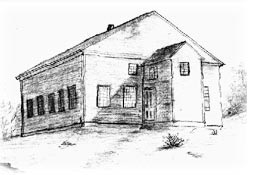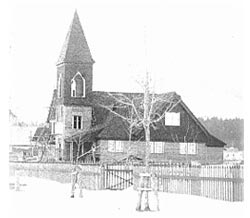FIRST CHURCH OF CHRIST, CONGREGATIONAL
United Church of Christ – North Conway, New Hampshire – Est. 1778

“No matter who you are or where you are on life’s journey, you are welcome here!”
HISTORY
The history of our church is inseparable from that of our New England towns. The first settlers of the Town of Conway came, for the most part, from the southeastern Province of New Hampshire where they had been members of the Congregational Churches of strict New England discipline; and they were accustomed to democratic church and town government as instituted by the Pilgrims of Plymouth, Massachusetts. They were willing to support the establishment of a Congregational Church and to be taxed for it. From the time of the first Town meeting here, provisions were made for the building of a church (referred in those days as the Meeting House). Taxes were paid to not only build the church but also to pay for a preacher to come for the church.
 The first Meeting House was built in the geographical center of the Town. There you can find a monument with a bronze marker commemorating the placement of the Meeting House. (If you wish to locate the monument, drive down Route 302 through Redstone to East Conway Road and turn left. The monument is located just past the police station.) The first Meeting House was moved to Center Conway by the Old Mill beside the Conway Lake bridge and was known as the South meeting House. The primary reasons for moving the first Meeting House were because it was not located in the real settlement and access to it demanded the sometimes difficult fording of the Saco river. he first Meeting House was built in the geographical center of the Town. There you can find a monument with a bronze marker commemorating the placement of the Meeting House. (If you wish to locate the monument, drive down Route 302 through Redstone to East Conway Road and turn left. The monument is located just past the police station.) The first Meeting House was moved to Center Conway by the Old Mill beside the Conway Lake bridge and was known as the South meeting House. The primary reasons for moving the first Meeting House were because it was not located in the real settlement and access to it demanded the sometimes difficult fording of the Saco river.
The first Meeting House was built in the geographical center of the Town. There you can find a monument with a bronze marker commemorating the placement of the Meeting House. (If you wish to locate the monument, drive down Route 302 through Redstone to East Conway Road and turn left. The monument is located just past the police station.) The first Meeting House was moved to Center Conway by the Old Mill beside the Conway Lake bridge and was known as the South meeting House. The primary reasons for moving the first Meeting House were because it was not located in the real settlement and access to it demanded the sometimes difficult fording of the Saco river. he first Meeting House was built in the geographical center of the Town. There you can find a monument with a bronze marker commemorating the placement of the Meeting House. (If you wish to locate the monument, drive down Route 302 through Redstone to East Conway Road and turn left. The monument is located just past the police station.) The first Meeting House was moved to Center Conway by the Old Mill beside the Conway Lake bridge and was known as the South meeting House. The primary reasons for moving the first Meeting House were because it was not located in the real settlement and access to it demanded the sometimes difficult fording of the Saco river.
On October 28, 1778, thirteen years after the Charter of this town was granted by King George of England eight persons organized this church: Timothy Walker, Martha Walker, Abiel Lovejoy, Anna Lovejoy, Thomas Russell, Sarah Russell, Richard Eastman and Abiah Eastman. These are still familiar names throughout our valley. The Town voted to call Dr. Nathaniel Porter as the resident minister, pay him 55 pounds a year and raise 65 pounds to build a house for him. Reverend Porter served the church until 1836. In 1792, a second Meeting House was built on Main Street in North Conway, just north of the present North Conway Cemetery. This edifice was called the North Meting House. Services alternated between the North and South Meeting House (Center Conway). The North Meeting House served the people of the surrounding area until 1855 when the Second North Meeting House was built. It was located at the corner of Locust Lane and South Main Street. This location was chosen because it was closer to the center of North Conway, The Second North Meeting House served the community until 1884 when the present building at 2503 Main Street was built. Shortly after the new church was finished, 28 members requested to leave and formed the Second Congregational Church in Conway, or was we refer to it today, The Brown Church.
In the late 1800’s, the nature of North Conway was changing from the original farming village to a busy area servicing at least 20 large hotels. The town was served by two railroads and the result was many summer visitors as well as summer residents. Erastus B. Bigelow, (owner of a summer home and large farm, Stonehurst in Intervale) believed the town needed a larger church closer to the center of town where visitors and summer residents could walk to church. As a result, he offered to plan and supply much of the cost of a new church. Unfortunately, Mr. Bigelow died before the church was completed, but his daughter, Mrs. Helen B. Merriman completed the financing for the church aided by her husband, Dr. Daniel Merriman who was the Pastor of the Congregational Church of Worcester, Massachusetts.
 Since the original building was built, the church has been remodeled to make room for Sunday School rooms in the basement, a kitchen and programs for needs that arose in the community: a school for small children, for 20 years the only Kindergarten in the village was conducted here under the direction of Carrie Gleason, and a clinic for children and adults aided first by Mrs. Scott Simpson and later by Dr. Clarence Vaughan. In 1965, Dr. Vaughan established a trust that resulted in the Vaughan Community Service, Inc. to promote health and well being in the individual, the family and the community. The Vaughan programs are housed in the Reverence for Life Building built in 1972 with funds provided by Helen Whitney Gibson. In 1996 vinyl siding was added to the church to enhance its beauty and to ensure it would remain structurally sound well into the future.
Since the original building was built, the church has been remodeled to make room for Sunday School rooms in the basement, a kitchen and programs for needs that arose in the community: a school for small children, for 20 years the only Kindergarten in the village was conducted here under the direction of Carrie Gleason, and a clinic for children and adults aided first by Mrs. Scott Simpson and later by Dr. Clarence Vaughan. In 1965, Dr. Vaughan established a trust that resulted in the Vaughan Community Service, Inc. to promote health and well being in the individual, the family and the community. The Vaughan programs are housed in the Reverence for Life Building built in 1972 with funds provided by Helen Whitney Gibson. In 1996 vinyl siding was added to the church to enhance its beauty and to ensure it would remain structurally sound well into the future.
Although our church has its roots back to the settling of the Town of Conway in 1765, it is not mired in the past. The church is alive and growing with a congregation dedicated to respect for the past but a clear vision for the future. If you live in our Valley or are just visiting stop by Sunday mornings at 10AM for a glimpse at a warm and friendly congregation who know no strangers.
